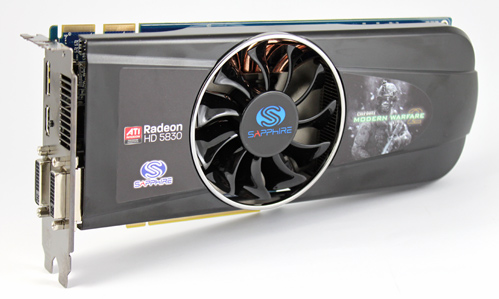Index

Review: The final piece of AMD's DX11 puzzle
Thanks to its Evergreen series and the absence of any meaningful answer from Nvidia, AMD is king of the DirectX 11 market. The Evergreen generation currently packs 11 different DirectX 11 cards with the fastest one being the HD 5970, which is at the same time currently the world’s fastest card. It has been 7 months since the first Evergreen card hit the market and AMD made sure that all market segments are covered for whenever Nvidia launches its DX11 hardware.
AMD now launches yet another Evergreen card named Radeon HD 5830. As the name suggests, the card belongs to the HD 5800 series and it’s based on Cypress graphics core. Radeon HD 5830 is a pretty interesting card as it comes with Cypress GPU bat is a bit crippled compared to the HD 5850 or HD 5870. Naturally, this shows on the pricing as well so gamers on a tighter budget will be able to enjoy the benefits of HD 5800 and DX11 at a lower price point.
Performance-wise, Radeon HD 5830 will sit between the HD 5850 and HD 5770. Nvidia’s competition will remain GTX 260 and GTX 275 until Fermi hits the market.
Since AMD decided against reference PCB design, all the partners are actually launching their own versions of HD 5830 graphics cards. Our today’s test sample is coming from Sapphire and it brings quiet operation, serious muscle and stability, as well as Sapphire’s gift game Call of Duty – Modern Warfare 2.

Radeon HD 5830 belongs to the gaming HD 5800 series, meaning it packs enough muscle and has what it takes to handle DirectX 11 effects. We’re saying this because we’ve already seen that some lower-end Evergreen offerings don’t really deserve the DX11 flag, and despite official support, they are pretty lacking in the performance department to really run DX11 games in all their glory. Fortunately, this is not the case with our today’s card.
Radeon HD 5830 features 1.79TFLOPs of computing power, its GPU runs at 800MHz and it has 1120 Stream processors. Compare this with the HD 5850’s 1440 SPs or the HD 5770’s 800 SPs, and you’ll get a clearer idea of what you should expect. While the HD 5870 comes with 16 thread processors (each has five ALU units that ATI calls stream cores) and 20 SIMD cores, the HD 5830 has 16 thread processors and 14 SIMD cores.
Like most Evergreen series cards, the HD 5830 uses fast GDDR5 memory running at 1000MHz (4000MHz effectively) and on a 256-bit memory interface. It has 56 texture units, compared to 72 on the 5850 and 40 on HD 5770. Just like on the HD 5770, it comes with 16 ROPs, which is half of what the HD 5850 has.
In a nutshell, AMD crippled the chip but clocked the GPU at 800MHz, which is higher than HD 5850’s 725MHz. Unfortunately, this reflects on the consumption and the card’s TDP stands at 175W, whereas the HD 5850’s TDP is at 151W. HD 5830’s minimum idle consumption is 25W whereas on the HD 5850, this number stands at 27W. In comparison, the HD 5770’s TDP is 108W and minimum consumption is 18W.
Apart from gaming potential, this card also uses ATI Stream technology enabling the HD 5830’s processor to be used for video and photo editing and taking some load off of the CPU. Support is not an issue as this technology already has backing by a few major players, most notably CyberLink, ArcSoft, ROXIO or Adobe. In case you’re interested in learning more on making apps with ATI Stream technology support, you can do so here. In fact, one of the currently hot topics is porting existing CUDA apps.
